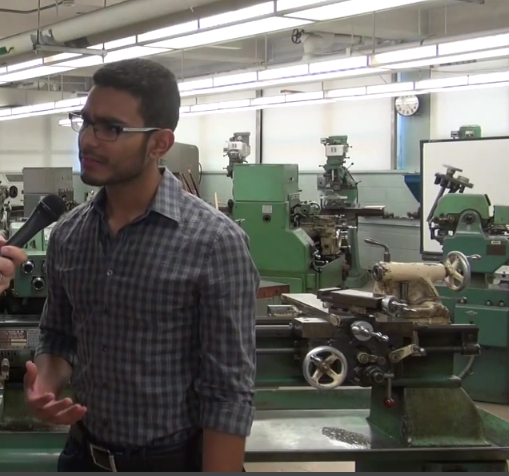
Marc Bussanich
Giancarlos Llanos-Romero stands in a lab at Queensboro Community College where a technology program teaches students how to operate traditional machines and use cutting-edge technology.
Giancarlos Llanos-Romero just graduated from Queensborough Community College and is aiming high for a technology career. He’s enrolling at Stony Brook University in the fall and then wants to work for NASA putting his mechanical engineering skills to work.
While at Queensborough Community College, which is part of the City University of New York and boasts a 16,000-student body, Llanos-Romero learned the basis for a mechanical engineering degree through the college’s STEM—science, technology, engineering and mathematics—program. It offers students an array of courses in a variety of fields such as biotechnology, engineering science and computer technology.
“As far back as I can remember, in my home country Columbia, I was always fascinated with the interconnectedness of mechanical systems and the different advancements in technology,”says Llanos-Romero, “Upon my arrival here, the CUNY system was the first university system that I encountered and I was just delighted with the different opportunities and curriculum they offered.”
In early May, Mayor de Blasio announced at the TechCrunch Disrupt Conference that the city would be allocating $29 million in this year’s budget, and $51 million next year, to bolster CUNY’s STEM programs.
“We need a broader approach that gets more and more people, especially young people, the skills that will give them opportunities of all kinds in this industry, and CUNY is the perfect tool for realizing that,” de Blasio said.
The commitment to CUNY is one component of de Blasio’s multi-pronged effort to reduce the city’s growing income inequality gap. He penned a piece for the Huffington Post during the 2013 mayoral race explaining how CUNY’s STEM program can play a vital role in helping graduates “fill all available local nursing jobs and a majority of skilled tech jobs.”
While de Blasio has described CUNY “as the engine that drives New York’s economy”, some observers say that CUNY isn’t living up to its full potential to connect students to work that provides real economic security. David Jason Fischer of the Center for an Urban Future, a New York City-based think tank, recently wrote an op-ed arguing that while CUNY is very good at providing economic advancement for hundreds of thousands of New Yorkers vis-à-vis its adult and continuing education programs, it has yet to emerge as a vehicle for providing workforce solutions on a larger scale.
“The reasons why CUNY has fallen short of its workforce potential range from how workforce programs are structured and funded, to the organization and culture of CUNY itself. Indeed, one challenge in assessing CUNY’s institutional progress toward effective workforce development is the premise that CUNY functions as a singular institution,” wrote Fischer. “Within the CUNY system, no central funding source exists to support workforce programs, nor does CUNY require its schools to report their employment or training outcomes.”
But recent developments, according to Fischer, bode well for CUNY strengthening its workforce development programs. One is a $20 million grant from the U.S. Department of Labor’s Trade Adjustment Assistance Community College and Career Training program that helped launch CUNY’s CareerPATH (Preparation for Adults Through Training and Higher Education).
CareerPATH, Fischer wrote, facilitated the kind of cross-campus collaboration CUNY needs. But, he added, still more coordination is needed. And the coordination among CUNY institutions would have to be accompanied with alignment between what CUNY teaches and what industry is looking for.
One of Giancarlos Llanos-Romero’s professors (the recent Queensborough graduate), Prof. Nick DiZinno, while standing in front of traditional metal lathe and milling machines in the college’s Technology Center, says the program works hard to stay abreast of evolving technological trends.
“We’re always looking at the industry to see what is the cutting edge. We are continually upgrading our lab equipment and our software. We make sure we’re communicating with our colleagues in the industry so that we know the skills our students need to learn,” he says. The machine shop, for instance, “will become an advanced manufacturing center where students will work on lathe and milling machines to build things the old fashioned way and then move onto to 3-D printing and computerized numerical control and other things that are the wave of the future,” DiZinno adds.
Students must also learn to adapt along with their chosen sector, he notes.”Students who graduate from Queensborough need to have a good work ethic, be a conscientious worker and be adaptable because technology is always changing. You can’t leave here and say, ‘My learning is done.’ You have to be able to learn throughout your entire career and adapt to new things.”
Llanos-Romero is confident that he’s got what it takes to get his dream job at NASA.
“Listen, I’ve already learned both traditional and modern manufacturing processes, and I also know how to work with 3D CAD Software that communicates with 3D printers thanks to the great courses here and professors like Professor DiZinno. I know I’ll be able to help develop fuel-efficient technologies, if not with NASA, then with another great employer when I enter the workforce,” Llanos-Romero says.









2 thoughts on “Can CUNY Career Programs STEM Income Inequality?”
More has to be addressed about the states challenge grant. For some mysterious reason City College was rejected for the grant.
Bigger issue should be addressed when it comes CUNY’s hiring process. How many former commissioners from city agencies do they employee?